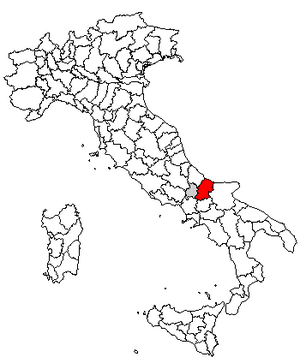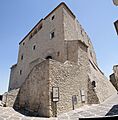Province of Campobasso facts for kids
Quick facts for kids
Province of Campobasso
Campobasso
|
|
|---|---|
 |
|
| Country | |
| Region | Molise |
| Capital | Campobasso |
| Area | |
| • Total | 2,909 km2 (1,123 sq mi) |
| Population
(2001)
|
|
| • Total | 230,692 |
| • Density | 63/km2 (160/sq mi) |
| Postal Code |
86010, 86010-86049
|
| Telephone prefix |
0874, 0875
|
| ISTAT | 070 |
| Vehicle registration | CB |
| No. of communes | 84 |
The Province of Campobasso is a cool place in southern Italy. It's part of the Molise region. The biggest city and capital of this province is Campobasso.
This province covers about 2,941 square kilometers (that's about 1,136 square miles). In 2017, around 223,871 people lived here. The province has 84 smaller towns and villages, which are called comuni in Italian.
Did you know that a small group of people from Croatia live in the eastern part of the province? They speak an old form of the Croatian language. You can find them mostly in towns like Acquaviva Collecroce, San Felice, and Montemitro.
Contents
A Look at Campobasso's Past
The history of Campobasso is very old! Long ago, from about 600 B.C. to 290 B.C., a group of tribes called the Samnites lived here. They were powerful and controlled a large area, including what is now Campania.
Later, the Romans took over. In 290 B.C., this area became part of the Roman Empire. After the Romans, in 570 A.D., a group called the Lombards invaded. They added the territory to their duchy (a type of kingdom) of Benevento.
The name Campobasso comes from the Lombards. They called the city Campus Vassorum, which means "Vassals' Territory." Vassals were like loyal followers or knights. Over time, this name changed to Campobasso.
Feudal lords, who were powerful landowners, gained more control. Around 1128, a Norman lord named Hugues II de Molise helped make Molise an independent area. This is where the region's name, Molise, comes from!
In 1806, after the French took control for a while, Molise became its own province. It included different districts like Campobasso and Isernia. Much later, in 1963, the province of Campobasso became its own region, called Molise. Then, in 1970, some towns left to form a new province called Province of Isernia.
Exploring Campobasso's Geography
The Province of Campobasso is located in eastern Italy, right on the Adriatic Sea coast. It has many different types of land. You can find tall Apennines mountains, rolling hills, peaceful lakes, and winding rivers.
The province is crossed by several important rivers. The Trigno (85 km long), Biferno (84 km long), and Fortore (110 km long) all flow through valleys here. Other rivers include the Tammaro, Saccione, Sinarca, and Sassinora. Most of these rivers flow into the Adriatic Sea.
One interesting spot is the Lago di Guardialfiera, a lake that covers about 7.45 square kilometers. Another lake is Lago di Occhito.
The capital city, Campobasso, is in the southern part of the province. It's located north of the Matese mountains, which are one of the main mountain ranges in the Molise region. If you visit the coast, you'll find popular towns like Termoli and Campomarino.
People and Towns of Campobasso
The number of people living in the Province of Campobasso has changed over time. In 1861, there were about 229,393 people. This number grew to 289,577 by 1951. Then it dropped a bit, but later went up again. In 2016, about 225,622 people lived here.
As of 2014, the biggest towns in the province are:
- Campobasso (with about 49,392 people)
- Termoli (about 33,478 people)
- Bojano (about 8,125 people)
- Campomarino (about 7,723 people)
- Larino (about 6,910 people)
- Montenero di Bisaccia (about 6,798 people)
- Guglionesi (about 5,422 people)
- Riccia (about 5,332 people)
- San Martino in Pensilis (about 4,827 people)
- Trivento (about 4,788 people)
Remember the Croatian minority we talked about? Acquaviva Collecroce is the largest of the three towns where people of Croatian origin live. It's believed their ancestors came from Bosnia-Herzegovina and Croatia in the late 1400s. They still speak a Croatian dialect along with Italian! The other two towns with Croatian roots are San Felice del Molise and Montemitro.
Cool Places to Visit
The Province of Campobasso has many interesting landmarks and attractions.
In the city of Campobasso, you can see the impressive Manforte Castle, which was built around 1450. There's also a beautiful cathedral and several old churches, like San Bartolomeo.
If you like history, you can visit Larino, a town that has been lived in since the 5th century BC! You can also explore the ancient Roman city of Saepinum, which has old buildings like a forum, basilica, baths, and a theater.
There are many large castles in the area, perfect for exploring. Check out the castles in Gambatesa, Castropignano, Civitacampomarano, and Termoli.
You'll also find many beautiful religious buildings. Don't miss the Trivento Cathedral, the Larino Cathedral (built in 1319), and the 12th-century Church of Santa Maria in Petacciato.
For a fun day by the sea, head to the town of Termoli. It's a popular seaside resort on the Adriatic coast!
Images for kids
See also
 In Spanish: Provincia de Campobasso para niños
In Spanish: Provincia de Campobasso para niños









